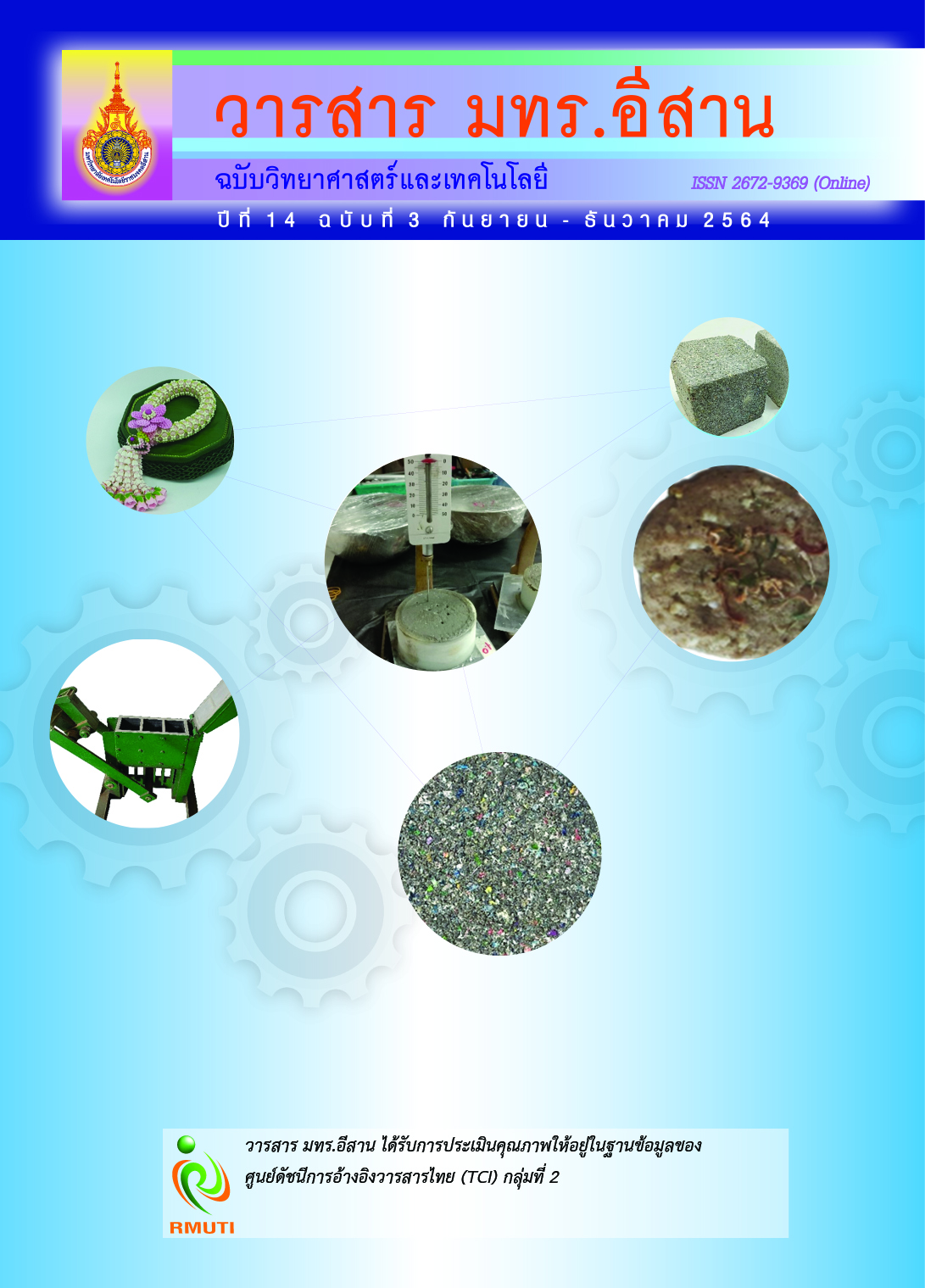Use of Polyvinylchloride Plastic Waste from Water Bottle Label in Pressed Concrete
Main Article Content
Abstract
This research aims to investigate the properties of pressed concrete with the partial replacement of limestone dust by recycled plastic waste derived from plastic bottle labels (Polyvinylchloride: PVC). Parameters affecting the mechanical property of concrete were studied, consisting of plastic replacement in percentages of 0, 10, 20, and 30 by volume, water to cement ratios (W/C) of 0.30, 0.35, and 0.40 by weight, and cement to an aggregate ratio (C/A) of 0.14, 0.17, and 0.20 by weight. The results showed that the density, compressive strength, thermal conductivity, and ultrasonic pulse velocity of pressed concrete decreased as the amount of plastic replacement increased. The high density of concrete resulted in a significant increase in compressive strength. The density of pressed concretes containing plastic waste can be increased by increasing the water to cement ratio and the cement to aggregate ratio. As considering the compressive strength according to Thai Industrial Standard for hollow non-load-bearing concrete masonry units (TIS 58-2533) found that limestone dust can be replaced by plastic waste up to 20 % when using water to cement ratio higher than 0.35 and cement to aggregate ratio higher than 0.17. This study can be a guideline for using plastic waste in concrete blocks and leading to an environmentally friendly material.
Article Details
References
Geyer, R., Jambeck, J. R., and Law, K. L. (2017). Production, Use, and Fate of All Plastics Ever Made. Science Advances. Vol. 3, No. 7, pp. 25-29. DOI: 10.1126/sciadv.1700782
United States Environmental Protection Agency. (2017). Advancing Sustainable Materials Management: Fact Sheet. Washington: DC 20460
Saikia, N. and De Brito, J. (2012). Use of Plastic Waste as Aggregate in Cement Mortar and Concrete Preparation: A Review. Construction and Building Materials. Vol. 34, pp. 385-401 DOI: 10.1016/j.conbuildmat.2012.02.066
Somdee, P., Nuilek, K., Hasuk, A., Bunont, C., and Wasantasenanon, P. (2014). Properties of Charcoal Briquettes Added Liquids Derived from Pyrolysis Process of Plastic Recycle. RMUTI JOURNAL Science and Technology. Vol. 7, No. 2, pp. 81-92
Almeshal, I., Tayeh, B. A., Alyousef, R., Alabduljabbar, H., Mohamed, A. M., and Alaskar, A. (2020). Use of Recycled Plastic as Fine Aggregate in Cementitious Composites: A Review. Construction and Building Materials. Vol. 253. p. 119146
Colangelo, F., Cioffi, R., Liguori, B., and Iucolano, F. (2016). Recycled Polyolefins Waste as Aggregates for Lightweight Concrete. Composites Part B: Engineering. Vol. 106, pp. 234-241. DOI: 10.1016/j.compositesb.2016.09.041
Mohammed, Azad A., Mohammed, Ilham I., and Mohammed, Shuaaib A. (2019). Some Properties of Concrete with Plastic Aggregate Derived from Shredded PVC Sheets. Construction and Building Materials. Vol. 201, pp. 232-245. DOI: 10.1016/j.conbuildmat.2018.12.145
Agyeman, S., Obeng-Ahenkora, N. K., Assiamah, S., and Twumasi, G. (2019). Exploiting Recycled Plastic Waste as an Alternative Binder for Paving Blocks Production. Case Studies in Construction Materials. Vol. 11, e00246. DOI: 10.1016/j.cscm.2019.e00246
Suweero, K. and Khaput, P. (2020). Development of Interlocking Concrete Paving Block Product Mixed with Colored Polyethylene Terephthalate Plastic Bottle from Post-Consumer Waste. Journal of Engineering, RMUTT. Vol. 18, No. 1, pp. 81-89
Nivetha, C., Rubiya, M., Shobana, S., Viswanathan, V. R. G., and Vasanthi, R. (2016). Production of Plastic Paver Block from the Solid Waste (Quarry Dust, Flyash & PET). ARPN Journal of Engineering and Applied Sciences. Vol. 11, No. 2, pp. 1078-1079
Arsod, N. D., Kannao, P. V., Botare, P. L., Nehare, K. V., and Ban, P. V. (2019). A Paper on Experimental Investigation on Concrete Paver Block and Plastic Paver Block. International Journal for Research in Applied Science and Engineering Technology (IJERT). Vol. 7, Issue 3, pp. 2151-2157
Tapkire, G., Parihar, S., Patil, P., and Kumavat, H. R. (2014). Recycled Plastic Used in Concrete Paver Block. International Journal for Research in Applied Science and Engineering Technology (IJERT). Vol. 3, Special Issue: 09, pp. 33-35
Seangatith, S. (2013). Optimum Cement to Limestone Dust Ratio in the Production of Concrete Blocks or Bricks. Thailand Concrete Association. No.20
American Society for Testing and Materials. (2015). Standard Practice for Mechanical Mixing of Hydraulic Cement Pastes and Mortars of Plastic Consistency. ASTM C305-15. Annual Book of ASTM Standards. Vol. 4, No. 1
Posi, P., Thongjapo, P., Thamultree, N., Boontee, P., Kasemsiri, P., and Chindaprasirt, P. (2016). Pressed Lightweight Fly Ash-OPC Geopolymer Concrete Containing Recycled Lightweight Concrete Aggregate. Construction and Building Materials. Vol. 127, pp. 450-456. DOI: 10.1016/j.conbuildmat.2016.09.105
American Society for Testing and Materials. (2015). Standard Test Method for Density, Absorption, and Voids in Hardened Concrete. ASTM C642-15. Annual Book of ASTM Standards. Vol. 4, No. 2


